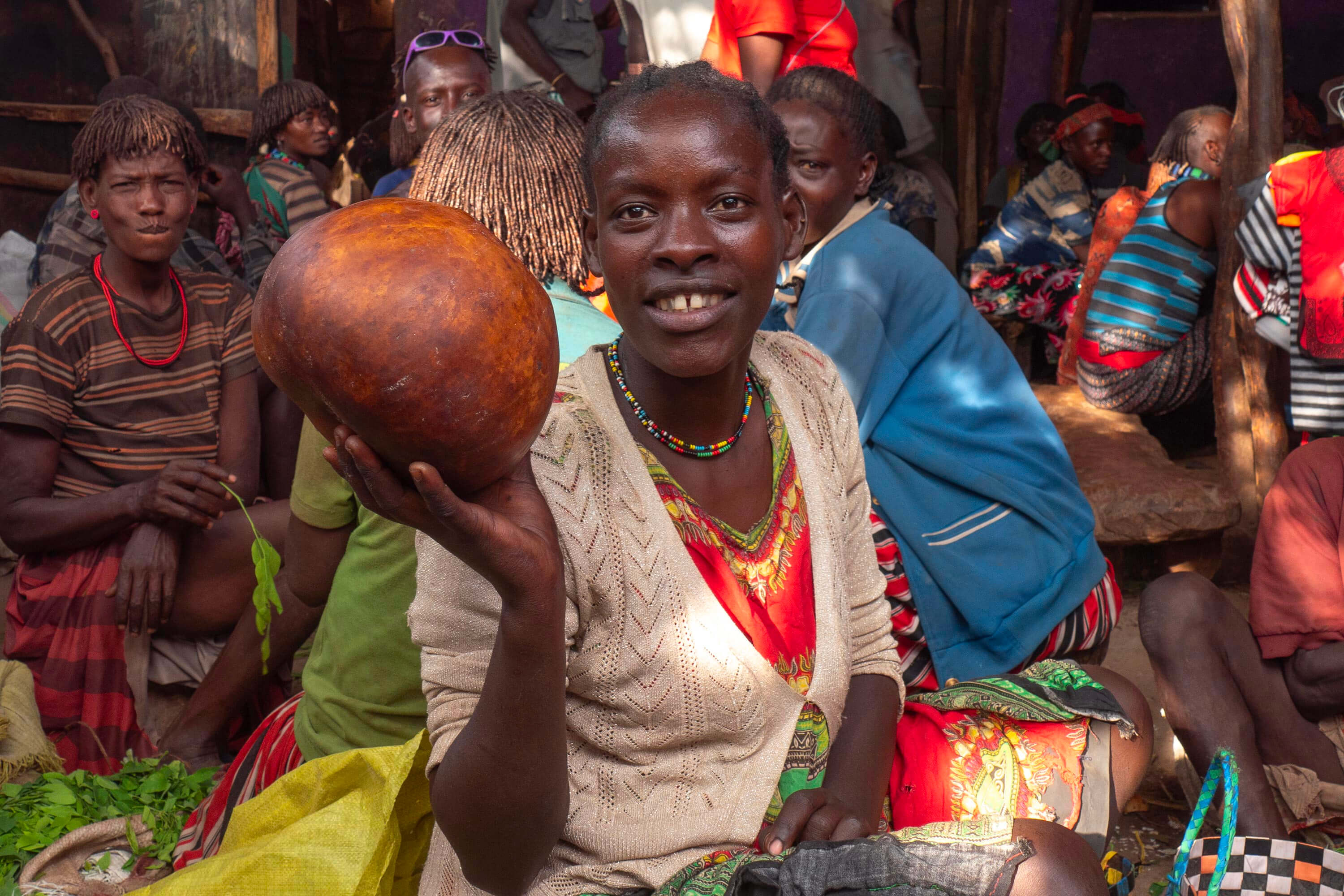The Tribes of the Omo Valley. Part one. Hamar and Banna
In the southwest of Ethiopia lies a special area called the “Southern Nations, Nationalities, and Peoples’s Region.” The heart of this zone is the Omo River, around which once formed a wide valley, becoming a place of residence for indigenous African tribes.
Most likely, the reader has heard about one of them. The most famous tribe is called Mursi, and its members have become famous for inserting a giant clay plate into their lower lip. The names of other tribes: Hamar, Banna, Surma, Karo, Ari, and others — are less well-known, but they are no less interesting than the Mursi.
In total, more than forty peoples live in the region. All the tribes listed above are small ethnic groups, each comprising less than one percent of the region’s population. For instance, the Hamar tribe accounts for only 0.31% of the population, and the Mursi even less at 0.05%. That’s just over ten thousand people. Vanishingly few.
Although the tribes speak different languages, many of them are merely dialects of one of the Omotic languages (Omotic — after the Omo River), so, for example, the Hamar tribe can communicate with the Karo tribe without an interpreter. However, some tribes speak entirely different languages, so a Hamar would understand almost nothing of what a Mursi tries to explain.
The religion of many tribes remains primitive animism, or the belief in nature spirits, as well as shamanism. However, according to statistics, only 7% of the population in the region adhere to paganism. Almost 80% of the population, including many tribes, are Christians.
Many tribes live in conditions close to primitive. Others are quite adapted to the modern world and even sometimes use computers and mobile phones. Despite this, the tribes as a whole are completely illiterate. In the Hamar and Mursi tribes, less than 10% can read and write. Naturally, there is a very high child mortality rate among them: about 20–30% of children die before reaching the age of 5, and the average life expectancy is only 50 years.
This is no joke, reader. This time we are literally heading to the cradle of civilization.
The Village of Jinka
A small “Bombardier,” resembling a stereotypical dictator’s plane from movies on Africa, takes off from Addis Ababa airport and heads toward the city of Jinka in southern Ethiopia.
From the airplane window opens a view of savannas with remnants of tropical forest, much of which is obstructed by the airplane’s wheel. Even from a great height, on the smooth surface of the cultivated part of the landscape become visible some “rash on body” resembling chickenpox. These are round African huts with straw roofs, called tukuls.

Upon arrival, it turns out that Jinka is considered a city purely out of respect. In reality, it is a deep village, and if not for the church standing in the “city,” Jinka could be reckoned a hamlet.
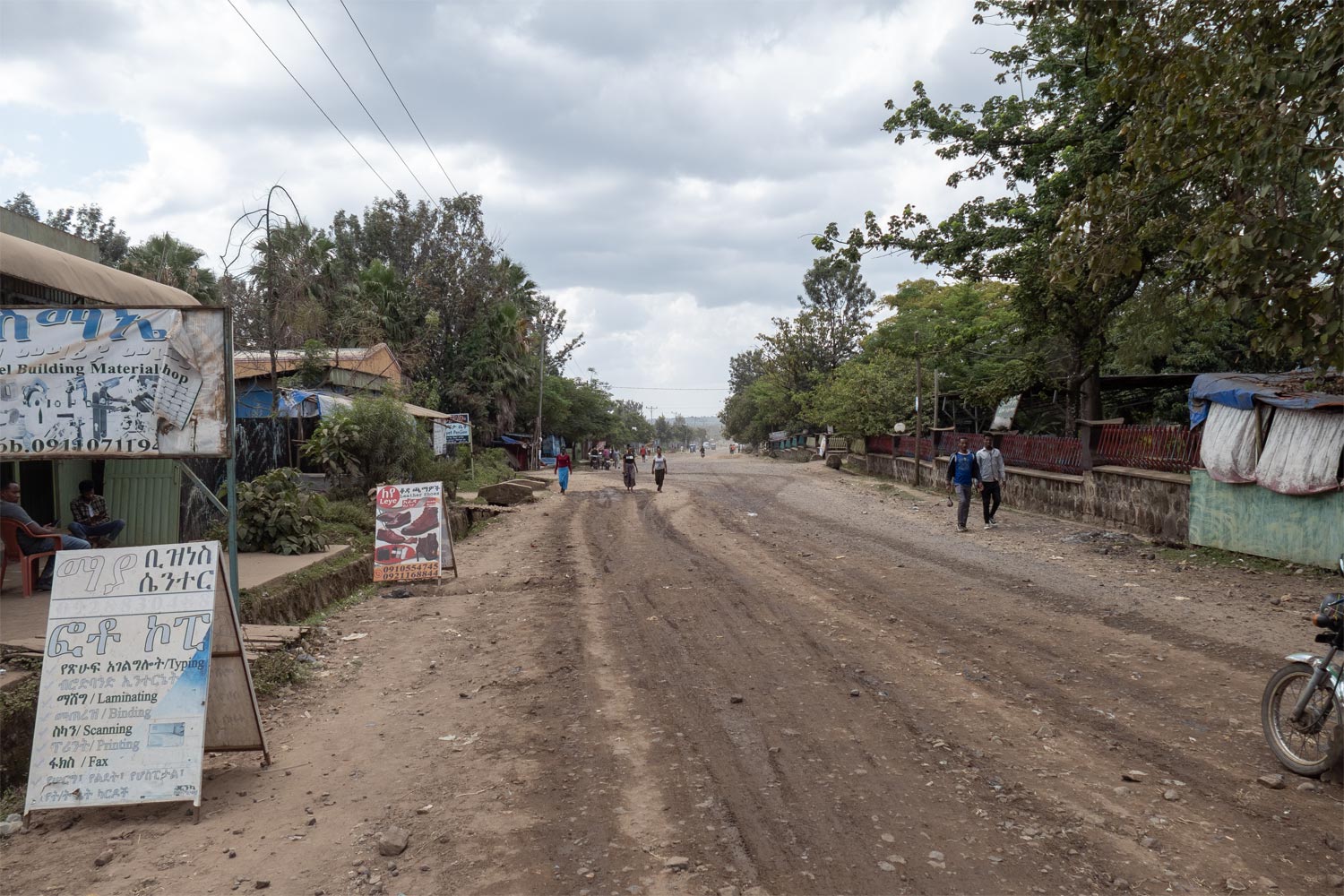
However, Jinka is far from the edge of civilization. Even a few hotels exist in the village, which would be better described as guesthouses. The “rooms” in such hotels usually feature a small bed with a sheet instead of a blanket and a mosquito net stretched above it like a dome. Malaria cases here are rare, but the regular mosquitoes can turn one’s body into the tukuled savanna.
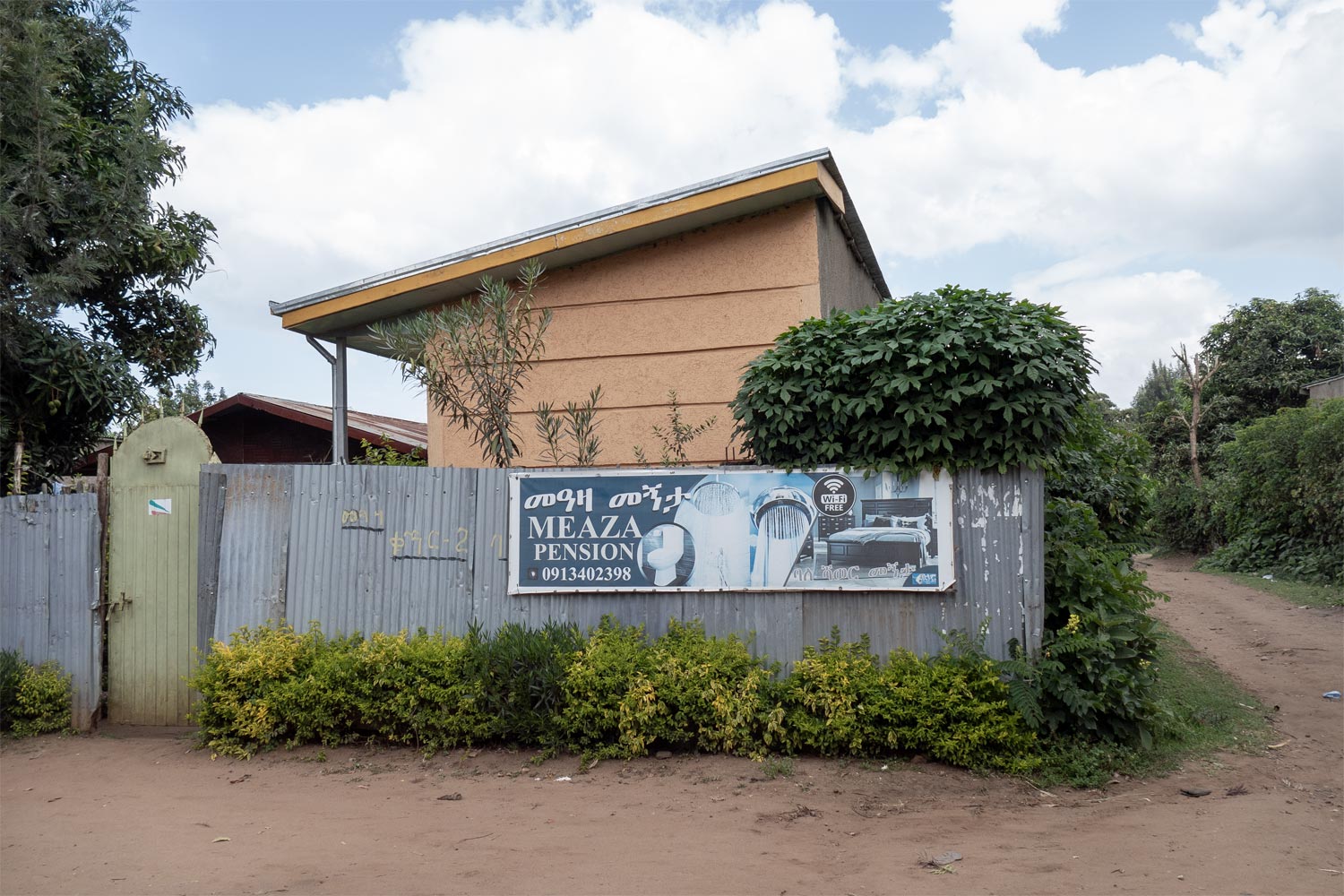
Even in such a remote area has a decent hotel with a restaurant. This luxury is aimed at foreigners who come to Jinka. Along with European and Ethiopian food, the restaurant offers good Wi-Fi and satellite channels.
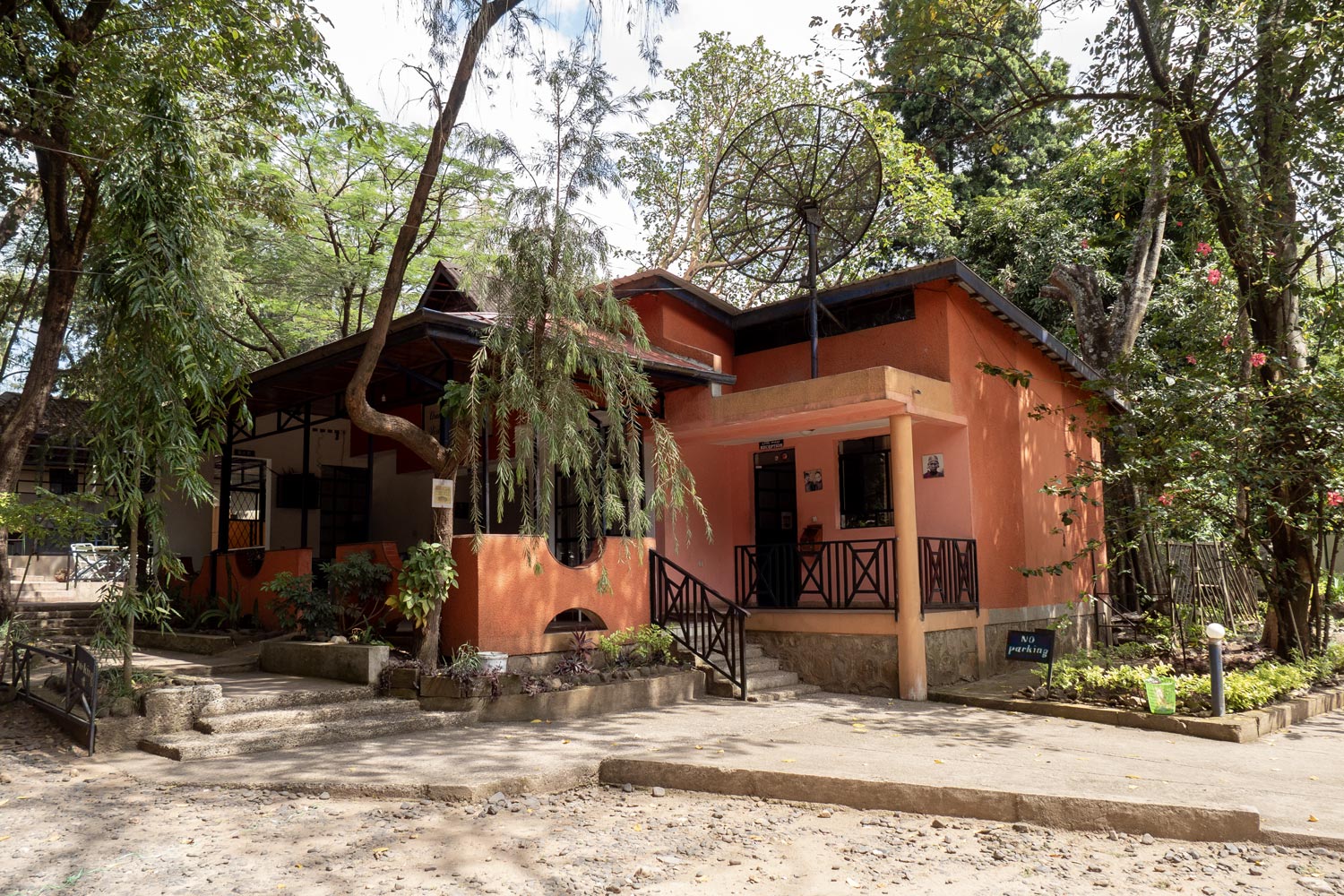
Obviously, there is nothing interesting in Jinka. The local market is a trampled field in the middle of village houses, where Ethiopians spread out blankets and sell Chinese trinkets on them.

On the streets surrounding the market one can find a slightly larger assortment of trinkets, this time hung on hooks inside something like market stalls.
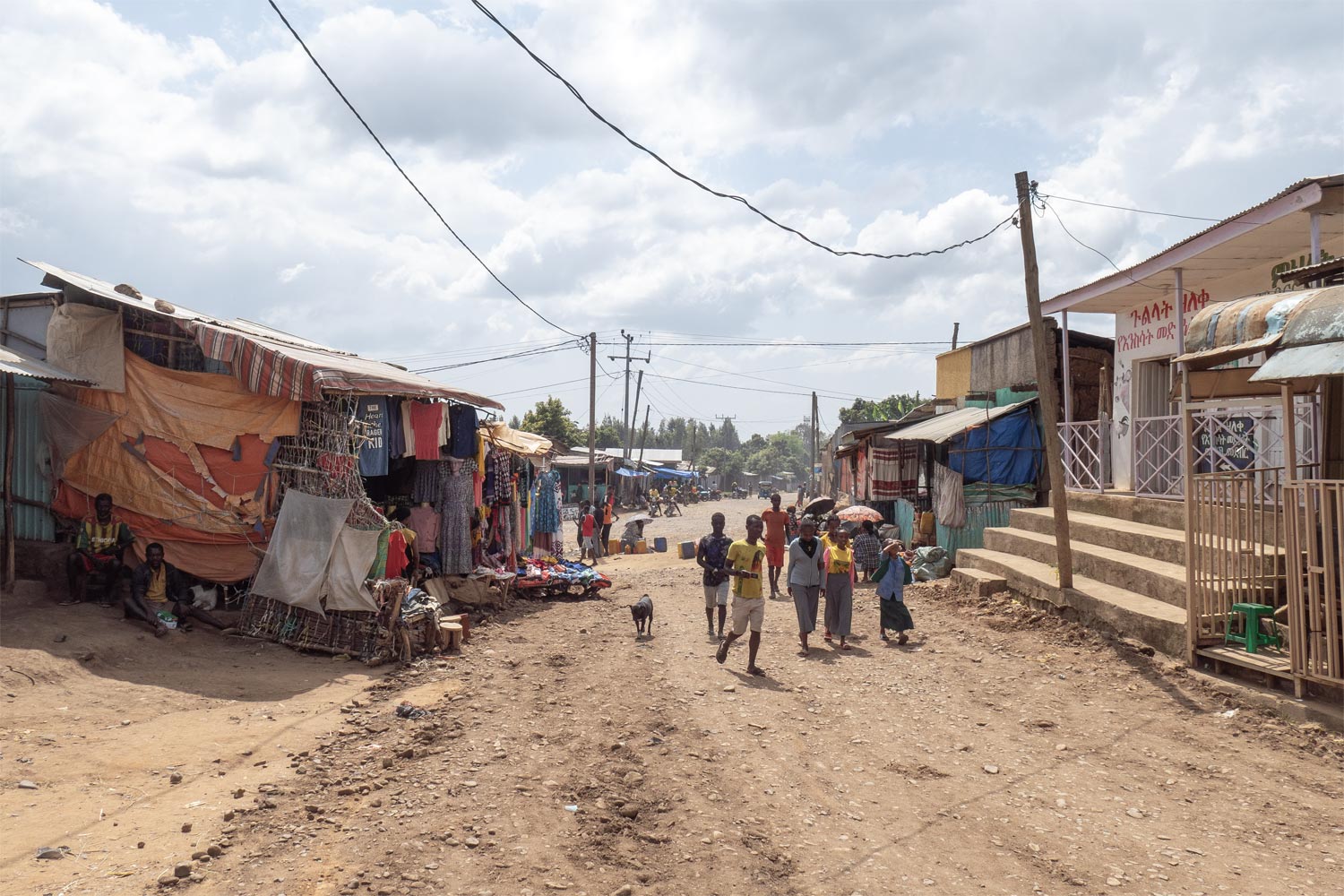
Besides clothing, in high demands at the market are spices, seasonings, seeds, and grains. They also sell tobacco, or more precisely, remnants of tobacco production, which an Ethiopian sitting in a tent skillfully wraps directly in notebook pages.
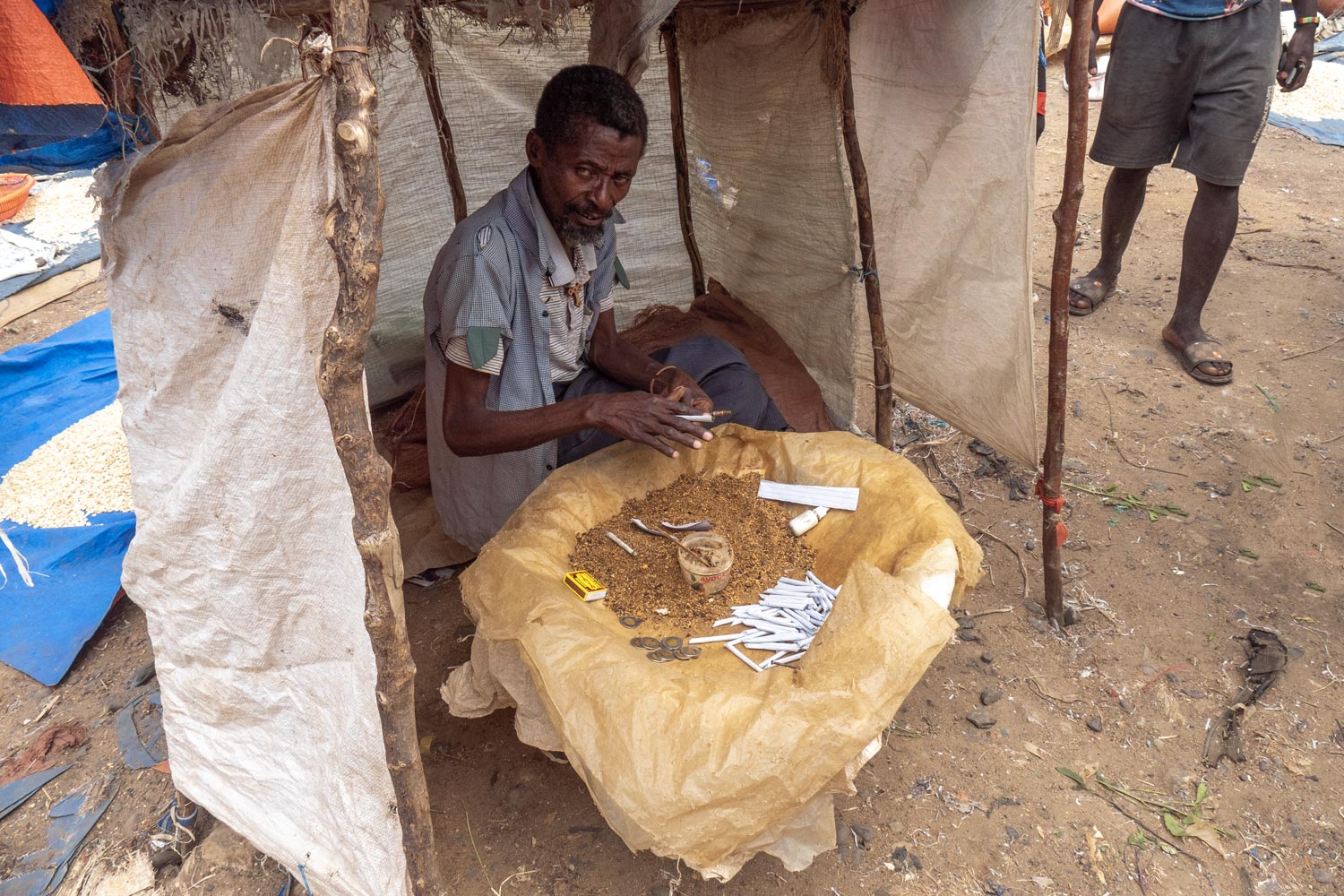
And of course, one’ll find moonshine at the market. It’s distilled from teff — an African version of millet. Ethiopian fellas from the market squat down and pour the moonshine right from gasoline cans, in which it is also stored.
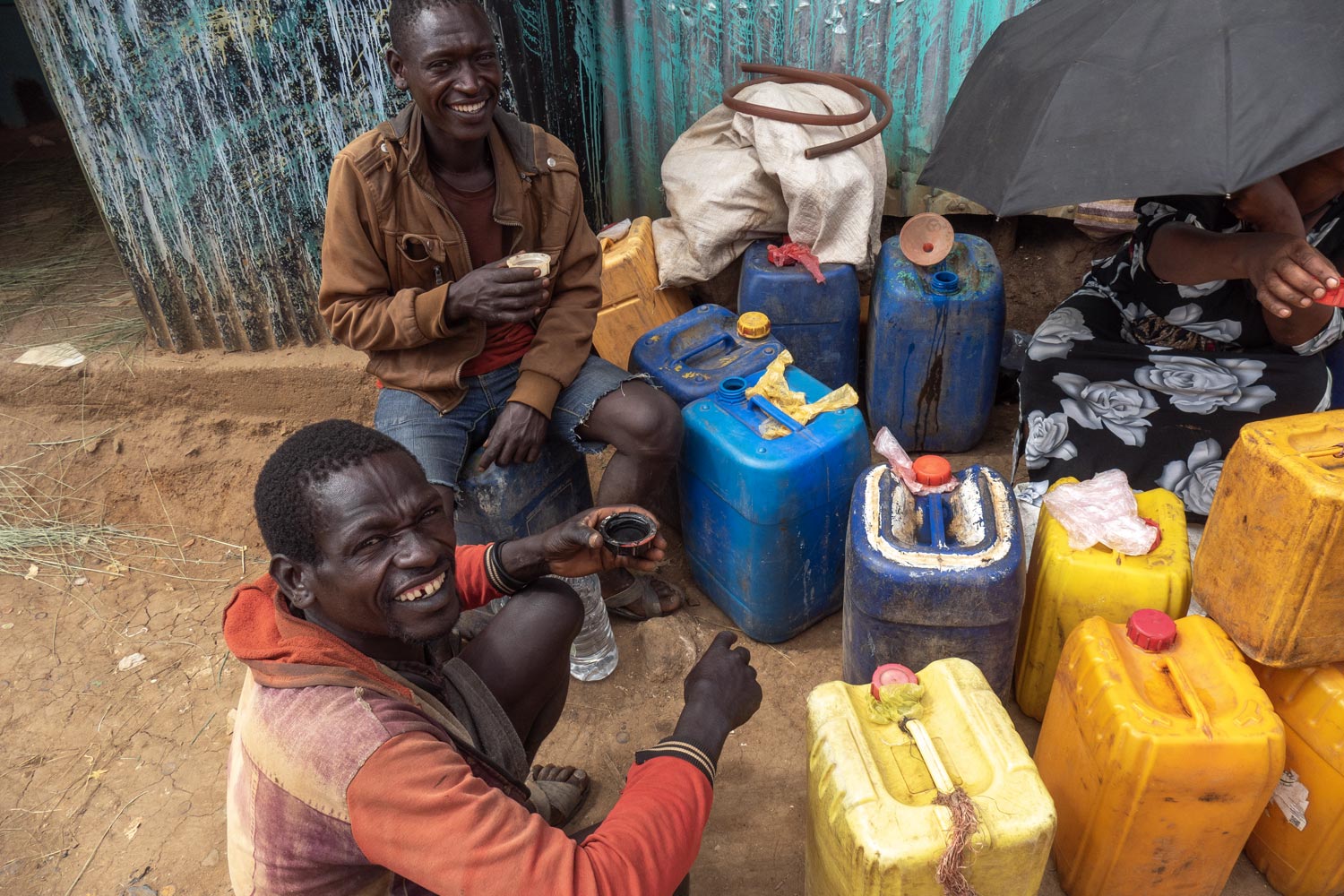
In short, there is literally nothing to do in Jinka. This village is used by travelers as a base where they can settle and visit nearby villages in search of African tribes. For this purpose, Jinka has an entire transport terminal with quite nice buses parked there.
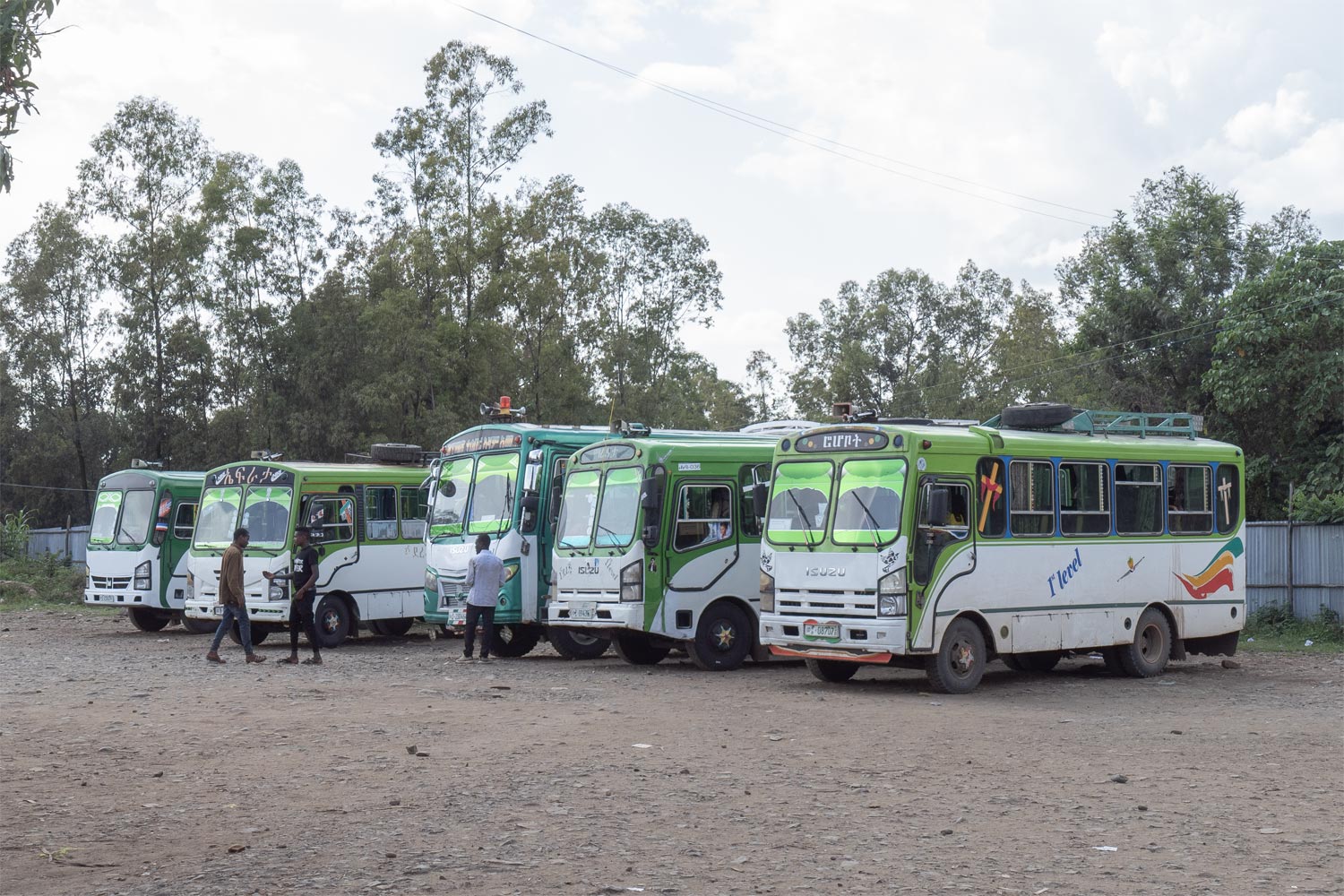
The buses, however, go to far more respectable places. The tribes are connected to Jinka by a legend of African roads—a Toyota minivan. This is the most versatile transport in Africa, a true workhorse that carries both sacks of grain and people. At the same time.
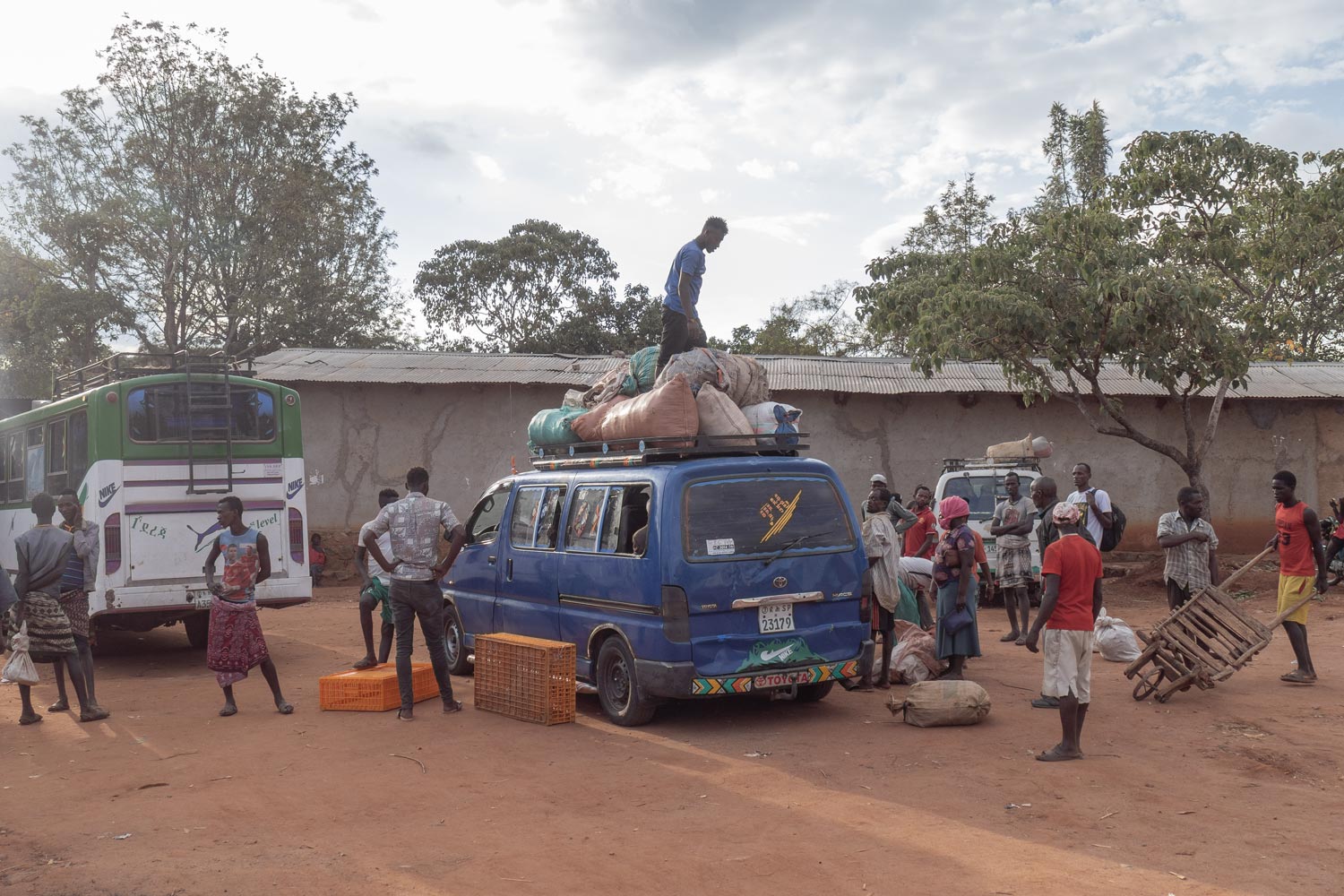
The Hamar Tribe
The easiest tribe to reach is the Hamar.
The tribes do not live in one specific place like a town or village. For tribal communities, it is more accurate to speak of a habitat range, much like for animals and plants.
The Hamar, for example, live over a large area south of Jinka. Their settlements are scattered throughout the savanna and connected only by dirt roads. Mostly, these settlements resemble the very “rash on body” visible from the airplane. Sometimes, they gather around a notional center that emerges without any particular reason, much like interstellar dust forms solar systems around random concentrations.
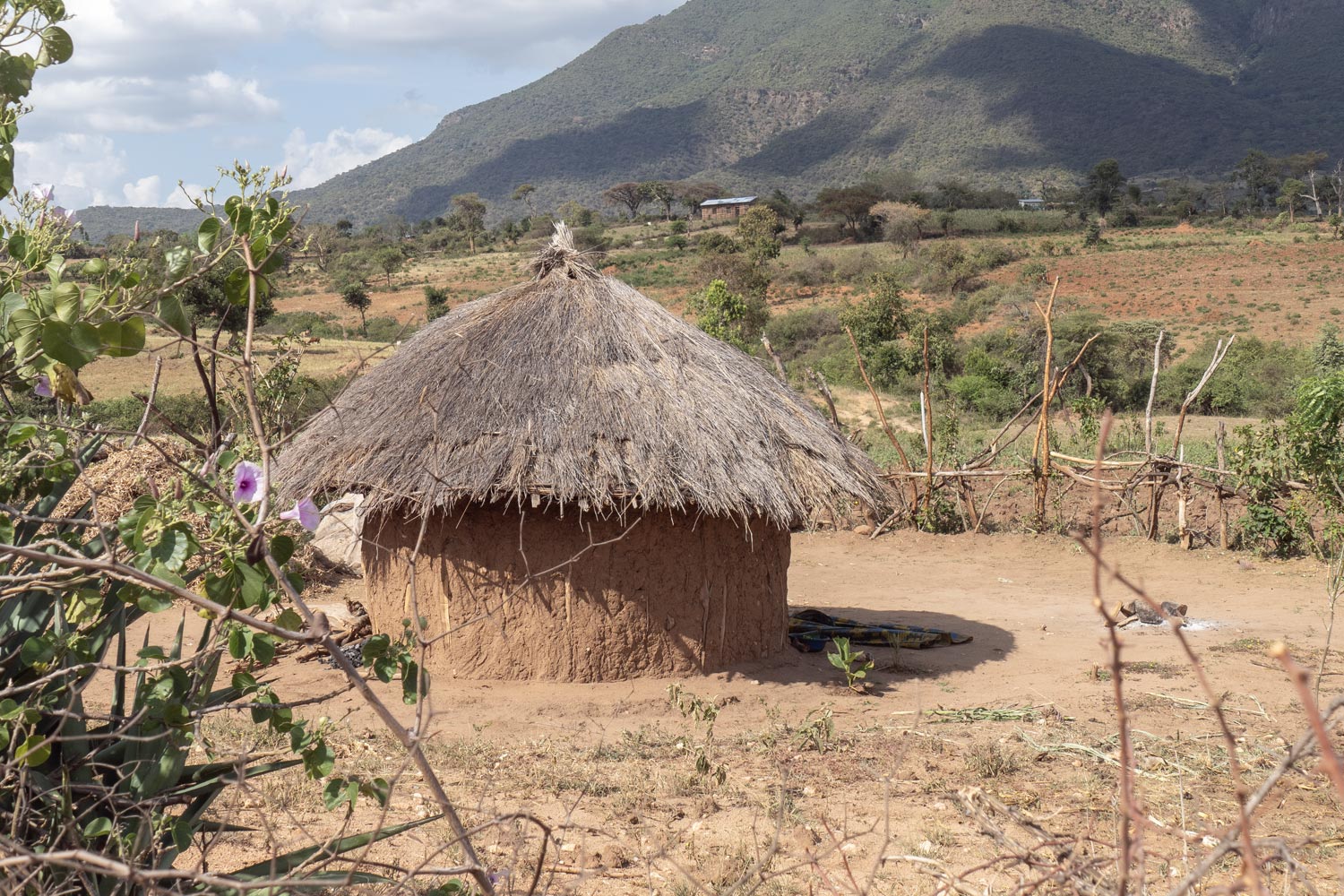
One of these centers of concentration is Key Afer — a village even smaller than Jinka. It is the nearest settlement, reachable in just an hour by minibus. However, it will be a challenging hour: the cabin is packed to the brim, it smells of sweat, and legs are pressed against the seat in front.
Key Afer turns out to be a typical African hamlet. The local “Broadway” stretches to the horizon — a wide street, all red from iron oxides, like much of the soil in Africa.
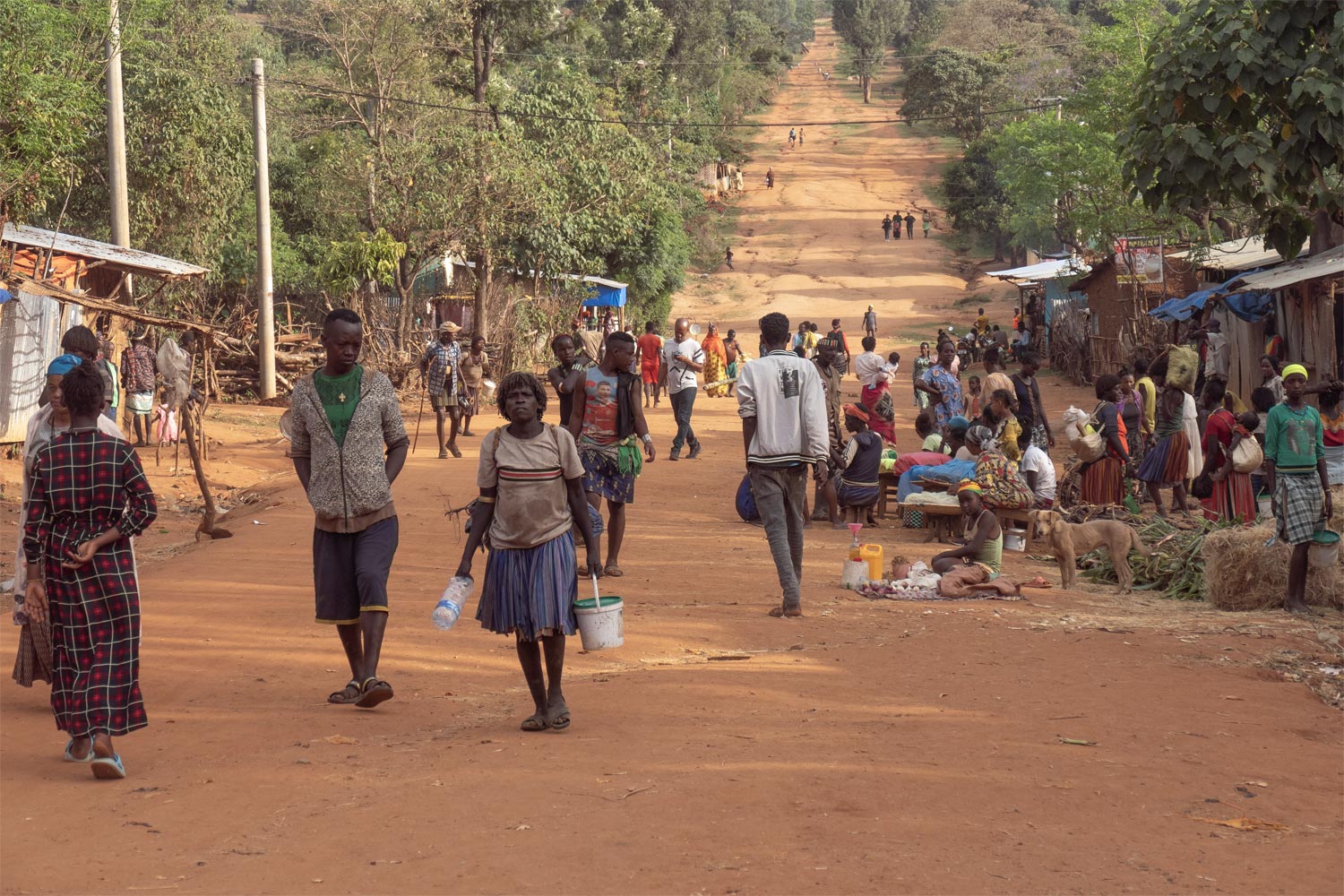
The “Broadway” itself is completely uninteresting. All the activity happens a bit off to the side, where lies a marketplace. Key Afer is the main trading town for the Hamar tribe. Every Thursday, and perhaps on other days, they hold here a fair. Although it is in many ways similar to the market in Jinka, the trade here is much more lively.
At the fair, one can even buy a souvenir. The Hamar sell handmade jewelry. Typically, these include wooden combs; necklaces made from beads, shells, and wooden pieces; rings and bracelets made of copper and aluminum; wooden or clay plates and saucers; animal figurines made of wood; decorative stools; busts shaped like African statues; clay pots; all sorts of masks, arrows, blankets, pieces of leather, forks and spoons, goblets and bowls — and other trinkets that in Europe can only be found in museums and at auctions.
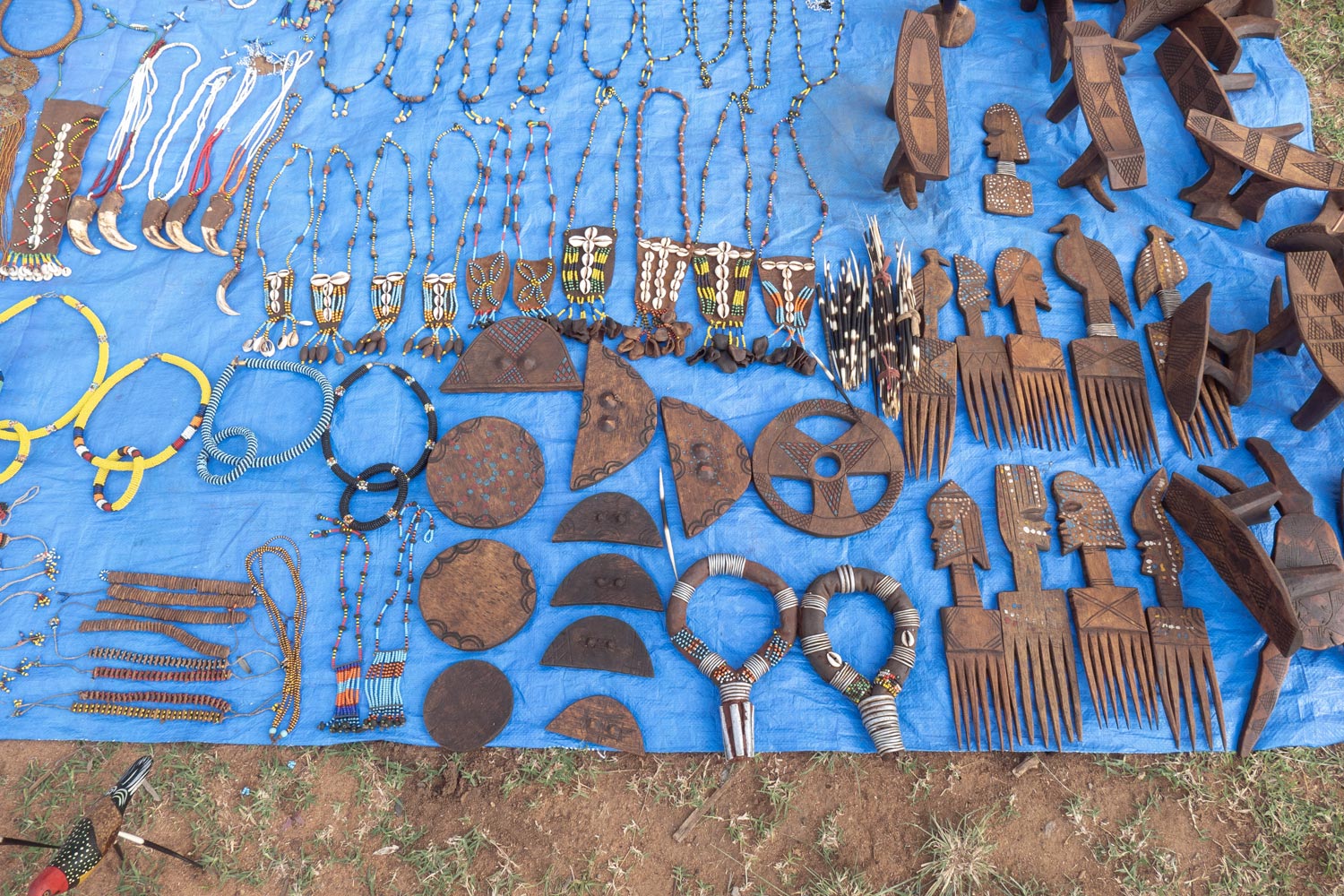
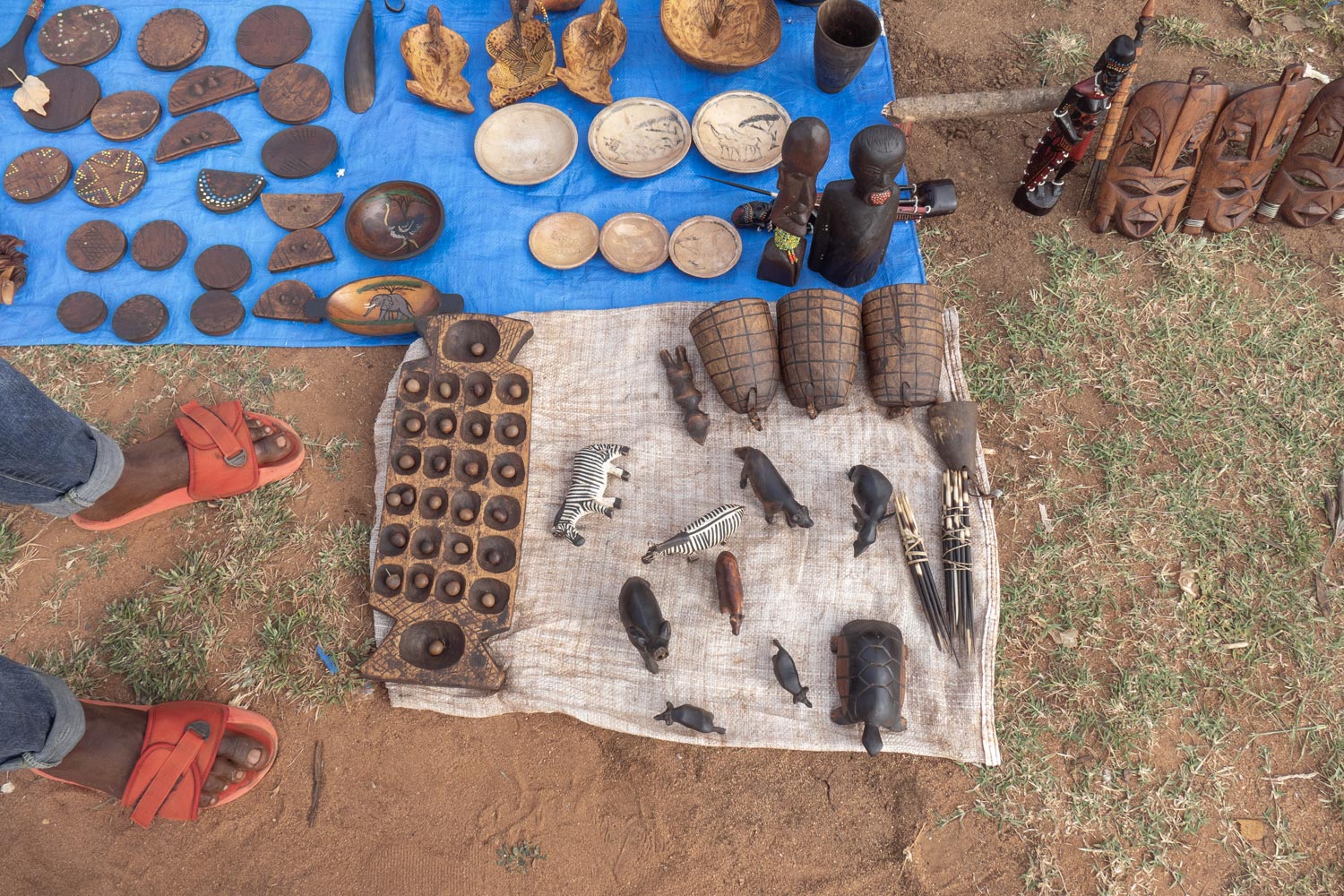
The most vibrant part of the fair is, of course, the people.
Each tribe wears its own distinctive clothing, which indicates the ethnic group of a person. However, this doesn’t always work. The Hamar and Banna are the two closest tribes in the Omo River Valley, one could say, brother nations.
It can be difficult to distinguish them by sight. Men of both tribes wear white or black headbands adorned with bead patterns, usually in blue, green, and red colors. Sometimes they wear something resembling a necklace made of the same beads, and occasionally a whole beaded scarf hangs around their neck. This wide band indicates belonging to the Banna tribe:
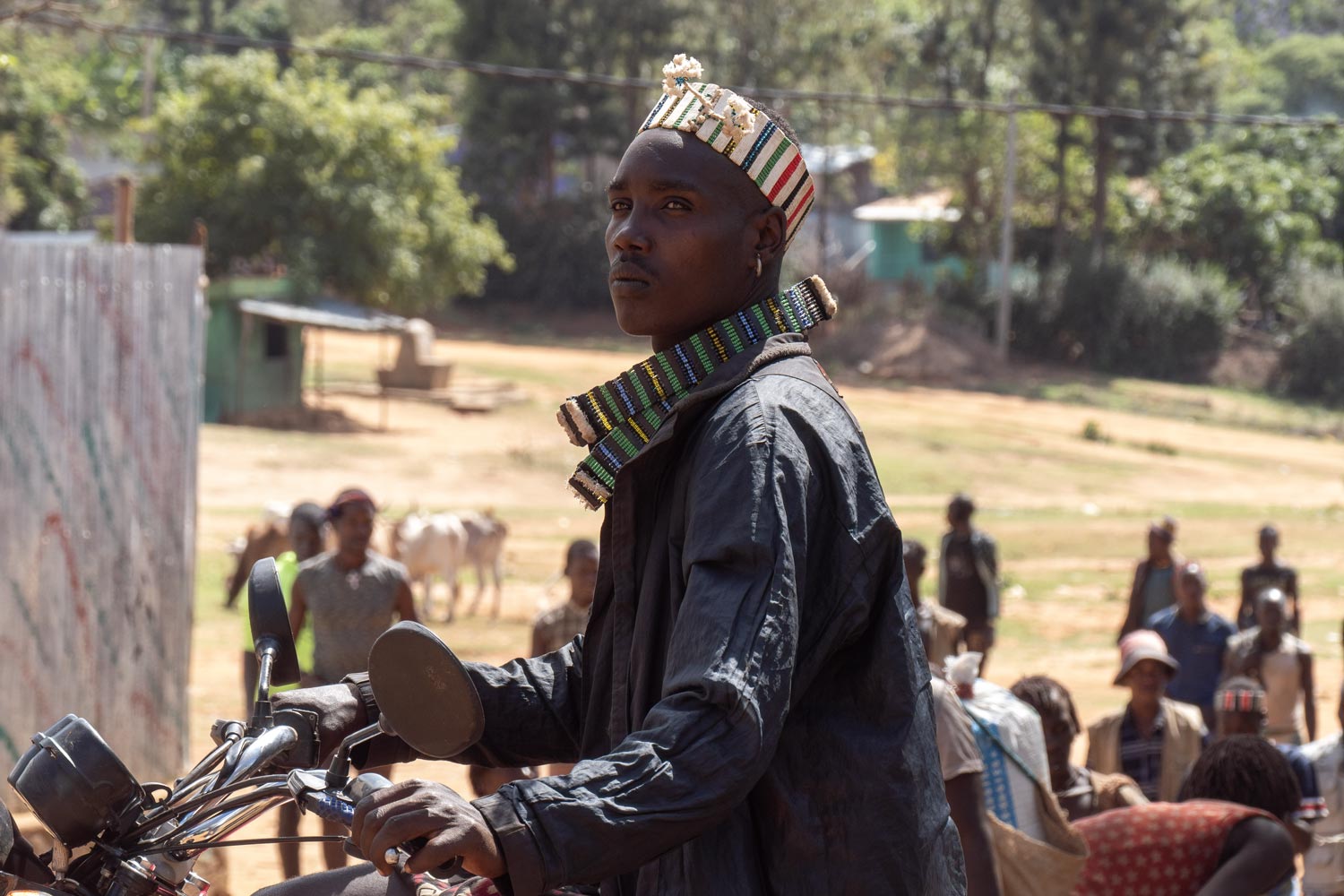
It seems that men of the Hamar tribe wear a narrower headband, which is adorned with only sparse bead accents.
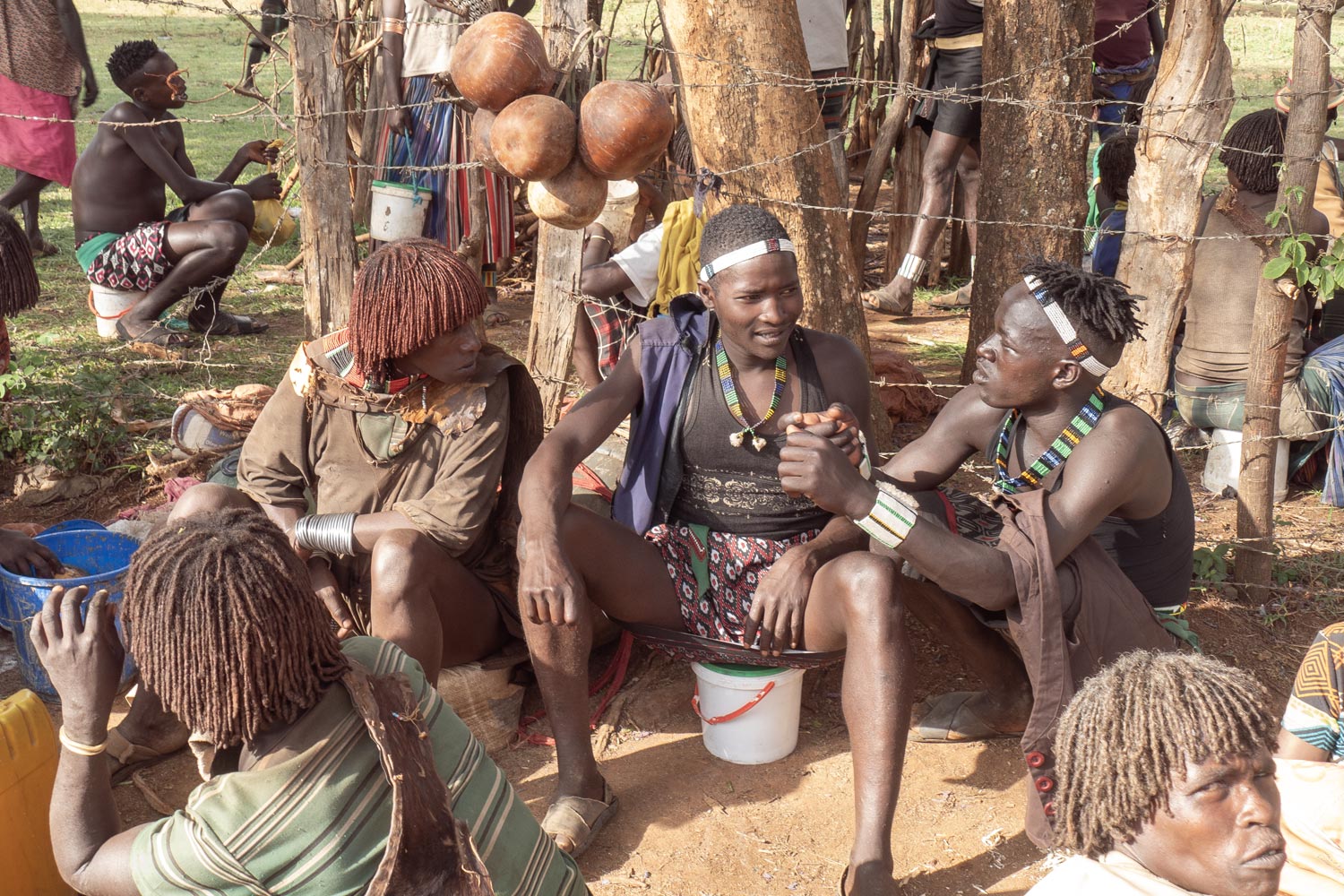
It’s even harder to distinguish the tribes in larger villages like Key Afer, where people wear a mix of African and European clothing. On the street, one might easily meet a local “businessman” wearing a jacket over an Ethiopian skirt and discussing the Kenyan stock market on his mobile phone. Who is he? Most likely a Banna. His tribe is more liberal than the Hamar.

Banna women wear similar headbands. Below the waist, they traditionally wear a colorful skirt. Unlike the coarse men’s skirt, which more closely resembles an Indian sarong, the women’s skirt is light, airy, and elegantly pleated. Like men, women often wear a regular T-shirt above the waist.

Hamar women are easy to distinguish from Banna women. They almost always wear thin, short dreadlocks styled in a way that resembles a bob cut.
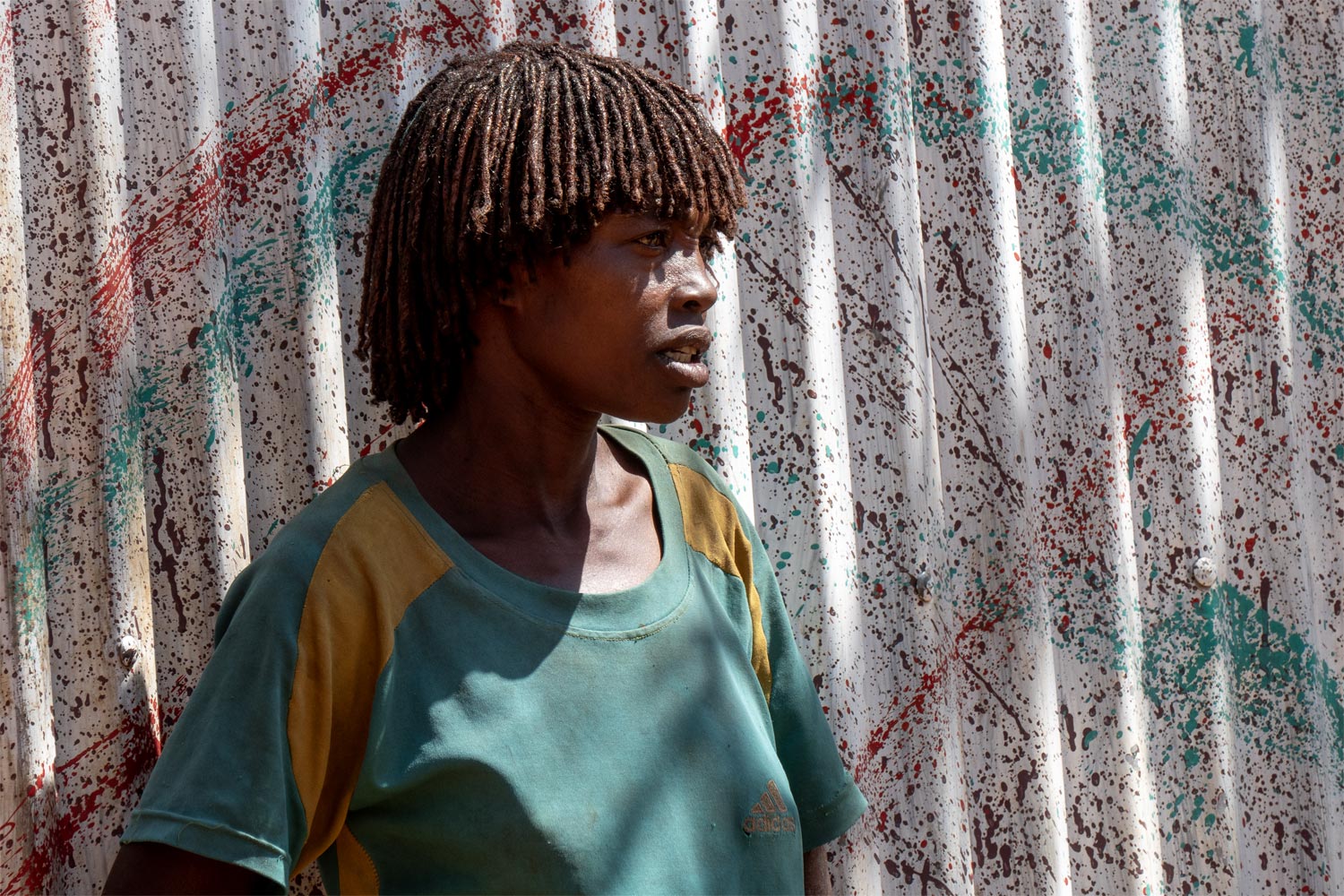
Although Banna women can also have dreadlocks, only Hamar women coat their hair with a mixture of ochre and clay to make it resemble the color of the red African soil. The author initially thought that the name of the tribe was related to the Arabic word “hamra,” which means “red.” Unfortunately, this beautiful theory turned out to be incorrect: the languages of the Omo Valley are not related to Semitic languages.

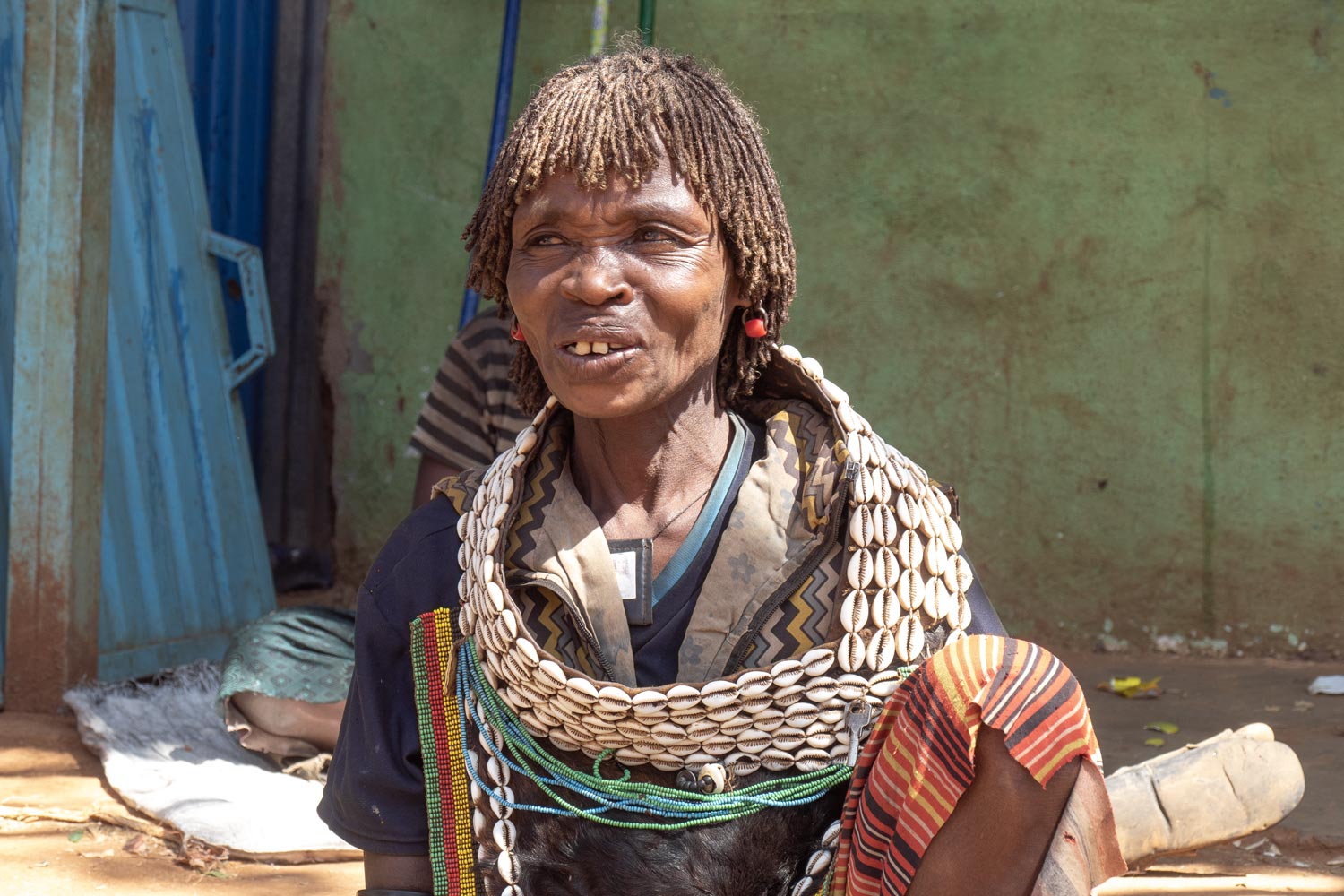
In addition to the Hamar and Banna, one can also meet other tribes in Key Afer, such as the Ari tribe. Members of this tribe usually wear a helmet carved from a gourd on their heads. This helmet serves partly as decoration and partly as protection from the sun.

The Ari sell similar gourds at the market, and they also use them as containers for water or oil.

There is a division of labor among the tribes. The Hamar and Banna engage in pastoralism and some agriculture, while the Ari focus solely on agriculture — hence they drink from gourds and wear them on their heads. Then they meet at the market in Key Afer to exchange goods. But why doesn’t each tribe do both?
The Omo Valley seems to have come straight from the pages of an economics textbook. Suppose the Hamar tribe slaughters one goat every 2 days and gathers a sack of grain in 4 days. Assume also that the Ari tribe slaughters one goat every 12 days and gathers a sack of grain in 6 days.
This means that the Hamar tribe produces more goats and more sacks of grain. But for each goat, the Hamar have half a sack of grain, while the Ari have 2 sacks. It turns out that both tribes benefit if the Hamar focus on goats and the Ari focus on agriculture, and then they meet at the market in Key Afer! This is exactly what happens in reality.
In economics, this phenomenon is known as the theory of comparative advantage. Although even primitive tribes lived by market principles, this theory was first described by economist David Ricardo in the 19th century. Two hundred years later, economist Peter Navarro convinced President Trump that the US economy would flourish by imposing tariffs on imports from China. If the Hamar tribe heard about this, they’d laugh that “economist” out of the village.
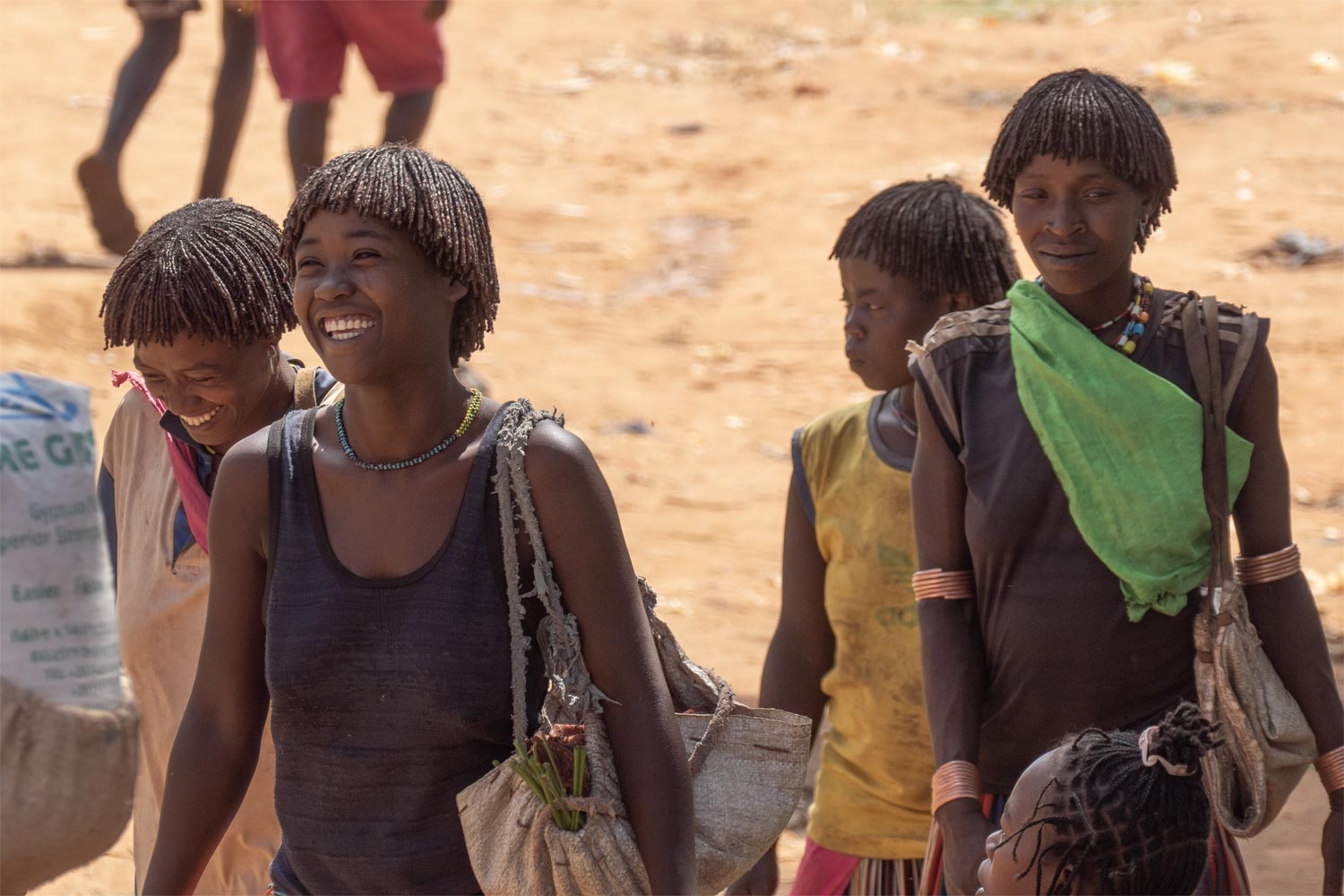
The reader is surely looking at the photographs and wondering: is it dangerous to visit the Omo Valley alone and photograph tribes in a remote African hamlet?
My answer is: yes, it is dangerous. Although the Hamar and Banna are the friendliest tribes, there are aggressive and crazy folks among them.
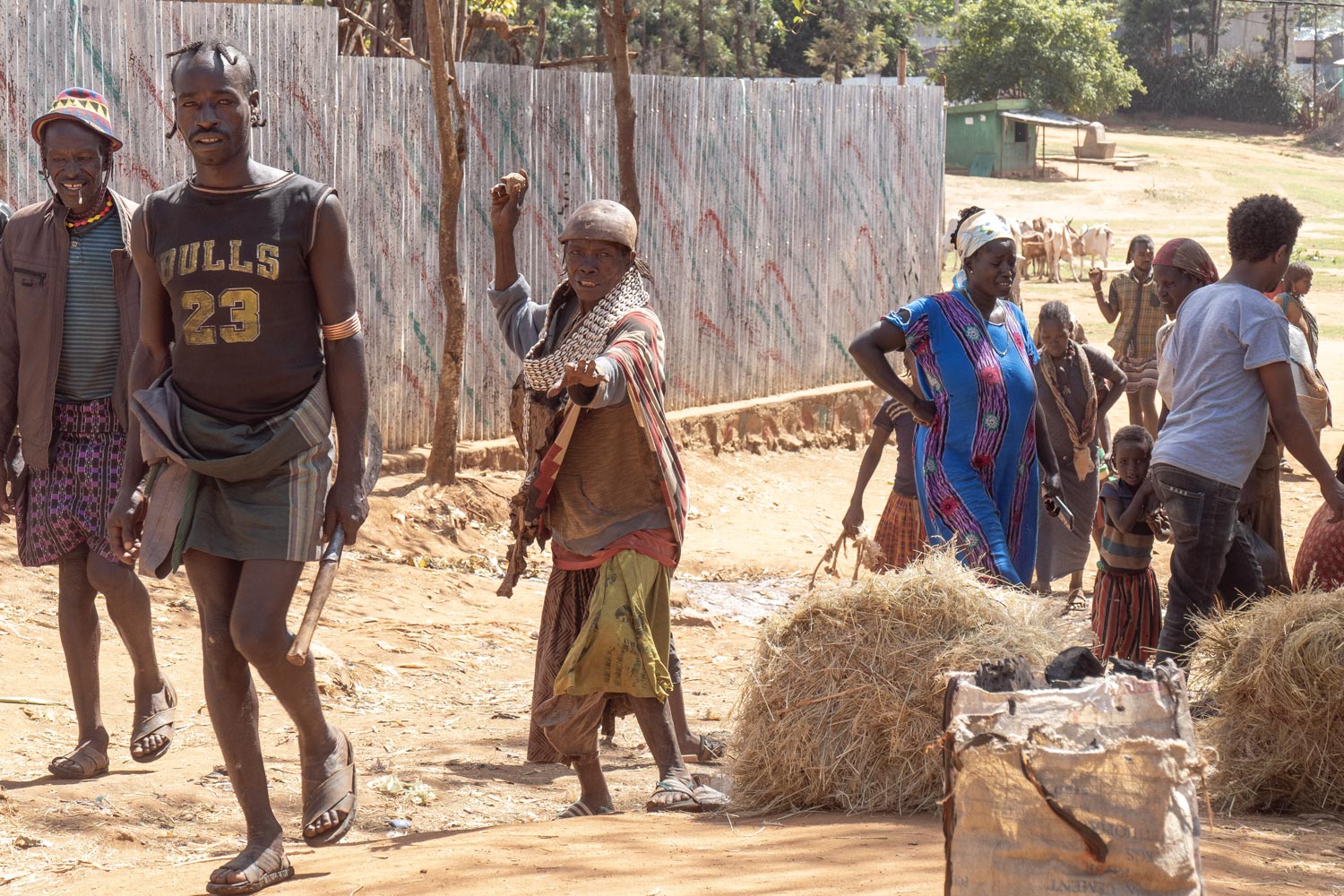
The author doesn’t know what was going through this woman’s mind. First, she raised a stone as if to throw it at me, then lowered it to the ground, came up close, and pointed at the camera. I took a few shots, after which she asked for money. It seems this was a local humor.
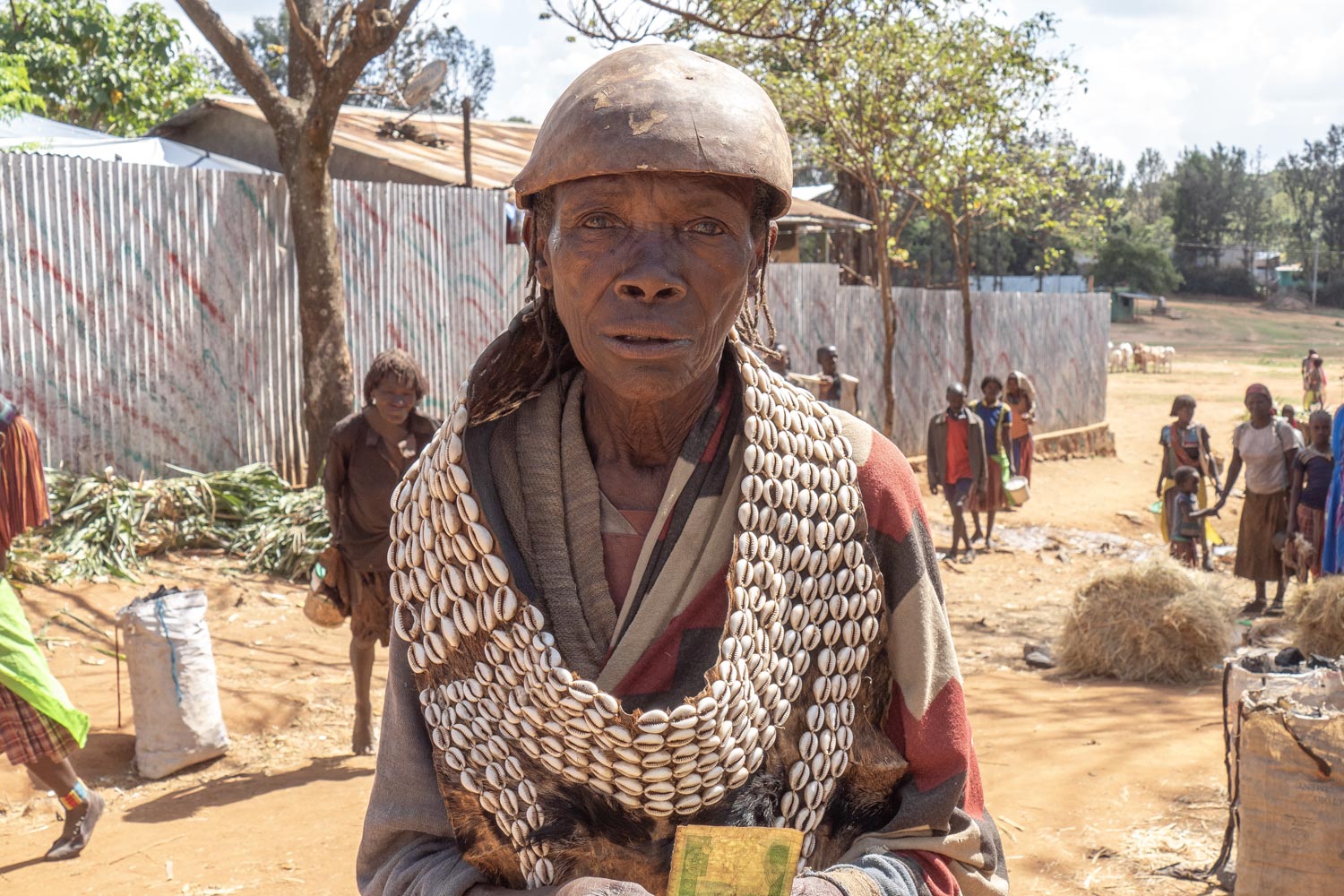
Although the Omo Valley remains a place where civilization has not yet fully reached, white tourists are no longer a surprise here. The tribes quickly realized that the black box around a tourist’s neck does something for which they can demand money. This has greatly harmed the tribes. Among the Hamar, it just led to the rise of their own “gypsies”; but the Mursi, overwhelmed by the stream of easy money, have simply drunk themselves into the ground.
Running on the Bulls
The Hamar tribe is well-known (in certain circles) for its ritual — bull jumping.
Unlike European civilization, the tribes do not have a specific age at which a person becomes an adult. Neither 16, 18, nor even 21 years old are considered special ages for them. We ourselves understand that these numbers are a construct of our culture, so it is unlikely to surprise the reader that instead of abstract numbers, the tribes have initiation rituals.
As soon as a boy from the Hamar tribe becomes strong and capable enough, his family gathers relatives, friends, and neighbors for his initiation into manhood. They also bring about a dozen large bulls, lining them up so that their sides are pressed closely together.
The boy’s task is to run naked across the backs of the bulls back and forth four times without falling even once!
To make life even more challenging for the boy (as if it weren’t already), the bulls’s backs are sometimes smeared with cow dung. This makes them slippery, and the spectacle becomes twice as entertaining. It’s said that sometimes the boy himself is also smeared with dung — supposedly to give him strength. Indeed, a very symbolic ritual for initiation into adult life.
If the boy successfully runs across the bulls, he becomes an adult and can marry and participate in men’s councils. Falling is a disgrace for him, but this disgrace is conditional: he can come back for a retake later, just like with a driving test.

And what are the girls doing during this time? They have their own ritual. While the boy runs across the bulls, the girls from his family ritually attack men with sticks or branches, urging them to lash them in return. The men respond by whipping the girls, leaving deep, bloody cuts across their backs. The girl who endures the beating most stoically wins. The deeper the wounds received and the longer she holds out without crying out in pain, the more respect she earns among the tribe.

The reader has just learned the commonly accepted description of the ritual. In reality, it’s not so romantic. The bulls are not exactly large but more like pumped-up cows. Only a wealthy family can afford a dozen bulls, and usually, there are no more than three. The author also couldn’t find any photographs showing dung. It is possible that the women are whipped against their will as well.

Attending the ceremony is difficult because it usually takes place in October and November. The author couldn’t catch it in Key Afer and took a significant risk by hiring a local tour guide (a random black man on the street) who took him into the remote African wilderness on a motorcycle.
One bull was found quickly. A local resident, black as coal, was plowing the land with it under the scorching sun.
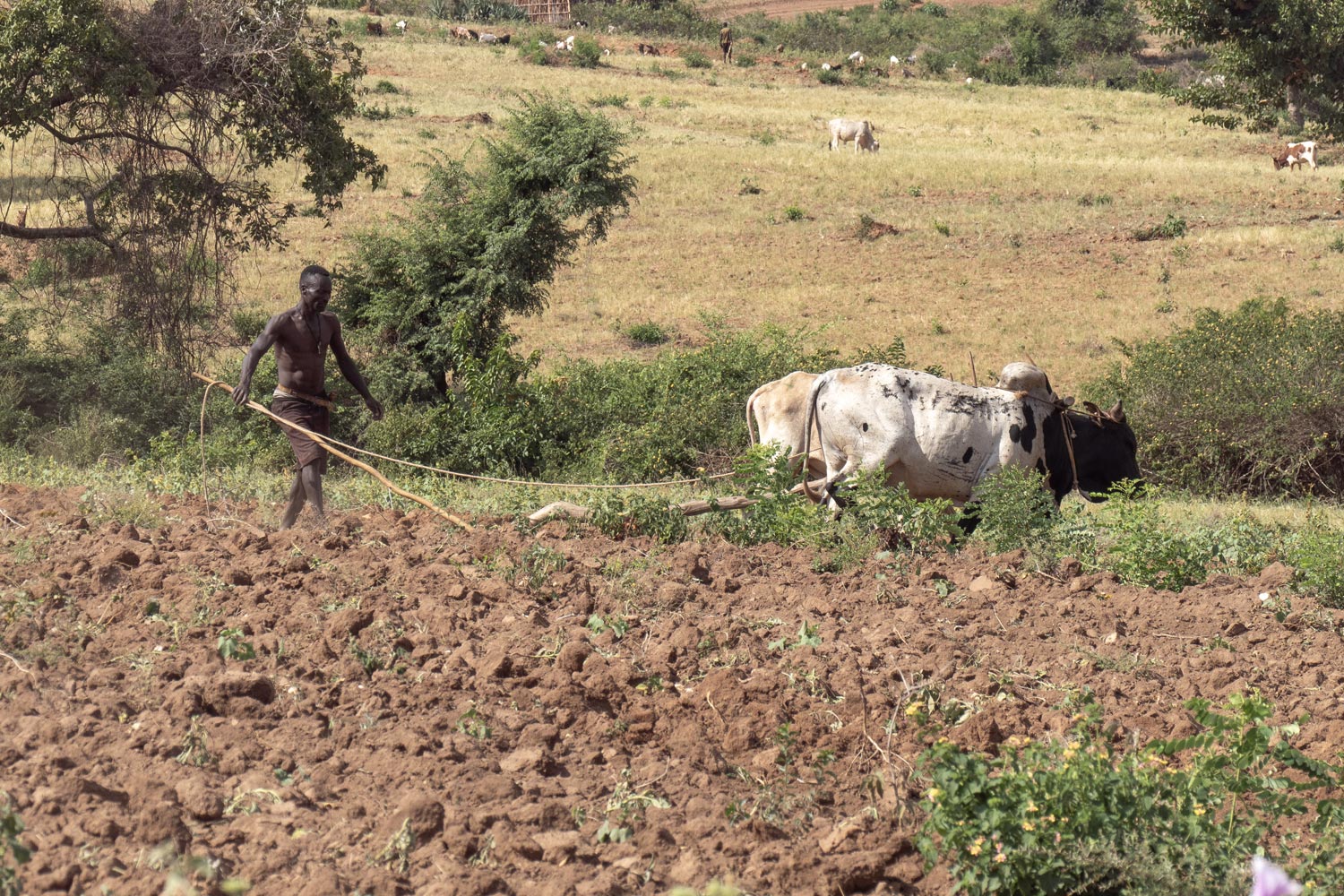
His home was a typical African tukul, and I encountered him still near the road, after which the motorcycle sharply veered into the savanna. Although tire tracks occasionally appeared on the ground, there was nothing around anymore: just cacti, thorns, and sparse trees.

Occasionally, amidst this wilderness, a solitary tukul would appear, surrounded by a circular fence — not against thieves, but against wild animals.
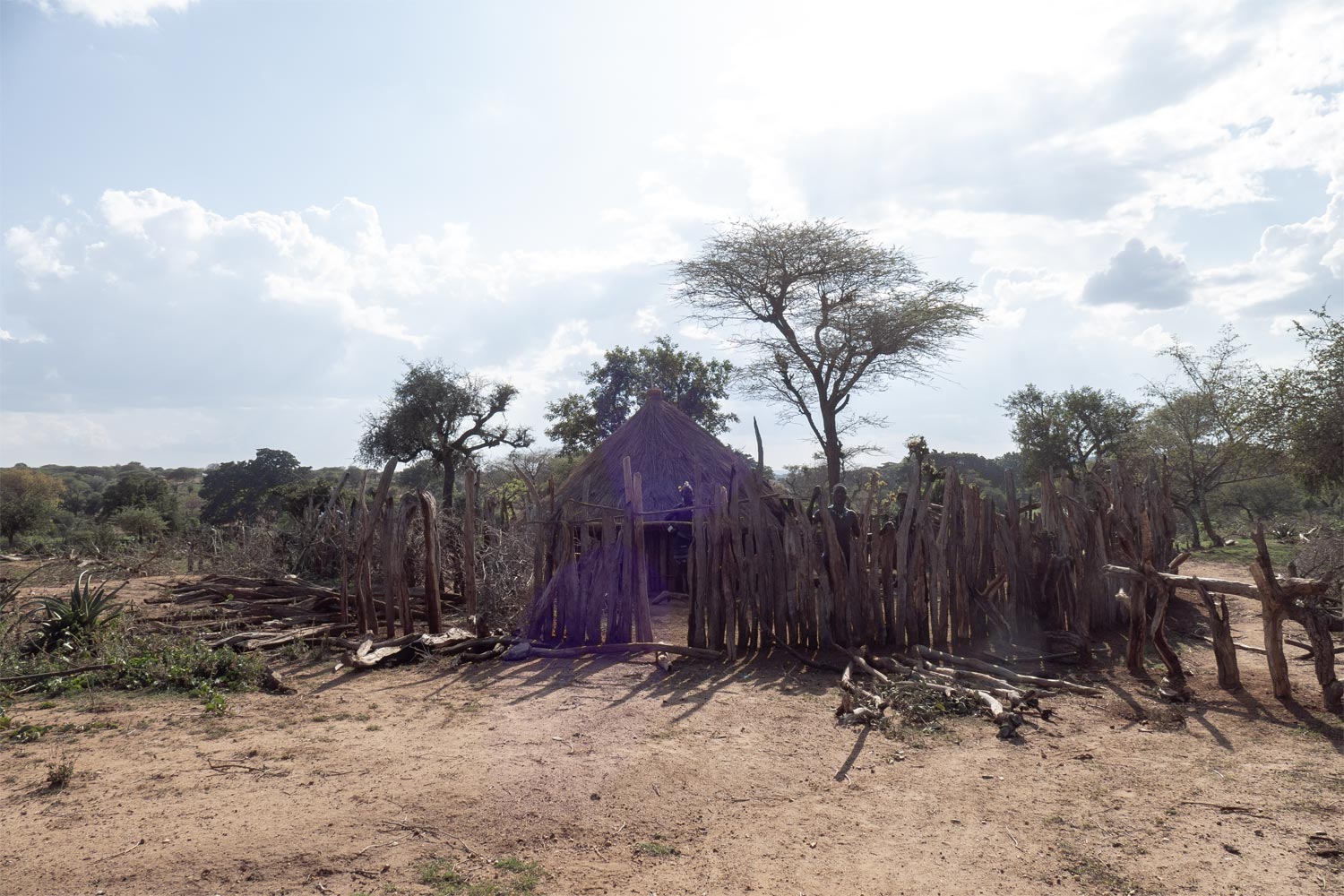
Honestly, I don’t even know exactly where I was. In this wilderness, even GPS doesn’t work properly. It must have been somewhere around here:
And suddenly, out of nowhere, in the middle of the savanna, appeared a school. A real elementary school!
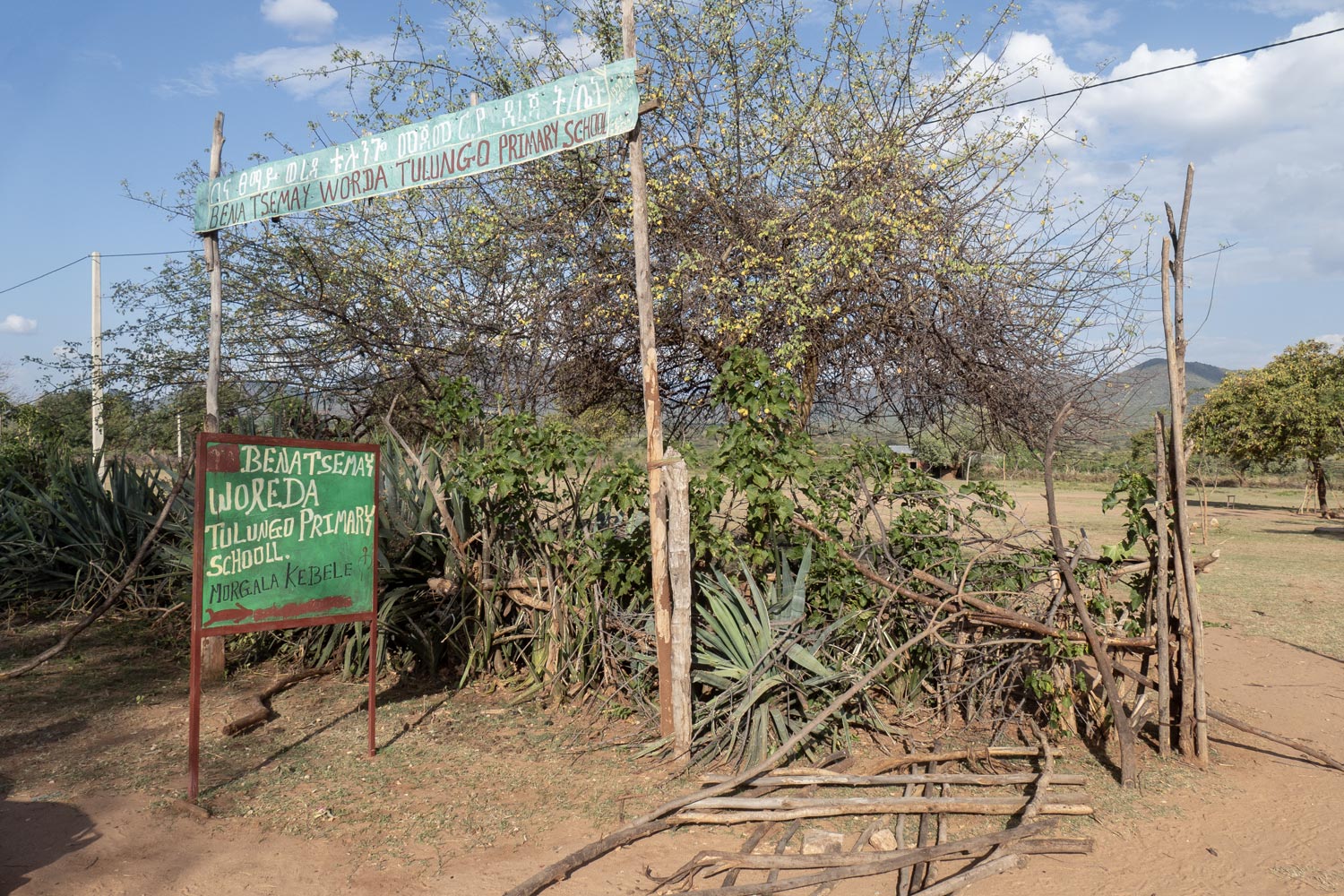
It seems there’s only one teacher who teaches everything: mathematics, geography, and English.


And we never found the bull ceremony. The folk drove me around the savanna for hours, from tukul to tukul, asking each family if they knew of anyone becoming a man that day. I still don’t understand what stopped him from simply killing me and taking all my valuables. Education, perhaps.
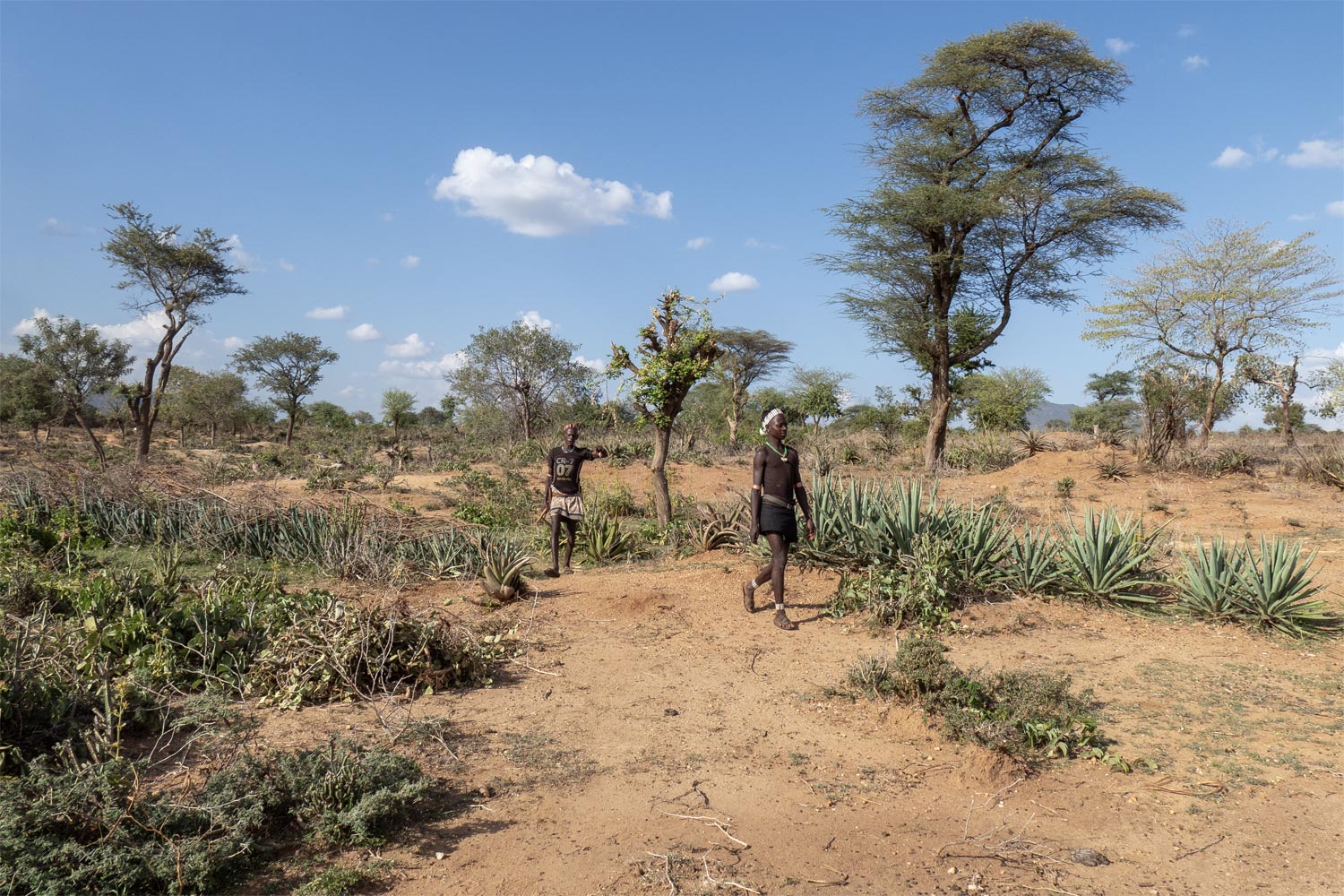
He returned the author to Jinka by nightfall, and the next day I headed to the Mursi tribe.
⁂
Life in the real, untouched Africa looks like this.
For dozens of kilometers around, there are no roads, cities, or even villages. Bipedal creatures roam the sandy land: on their feet are worn-out sandals, on their bodies are tattered T-shirts; sometimes they wear nothing at all. They sleep in homemade huts right on the ground, raise goats and drink water from the river, hunt and roast their catch over a fire, and compete in running on the backs of cows.
At the same time, other bipedal creatures reside in stone towers as tall as a hundred bulls, where it’s cold as night even on the hottest day. Every morning, they come to these towers, stare at glowing rectangles for hours, and move their fingers, then, in the evening, leave to sleep elsewhere. They sleep on strange pedestals covered with thick layers of soft fabric, get their food from cold boxes with lights, and hardly ever walk — unless prescribed by a doctor.
Both creatures belong to the same species. We are humans. But somewhere along the crossroads of history, one of us took a wrong turn. The only question left is who.
